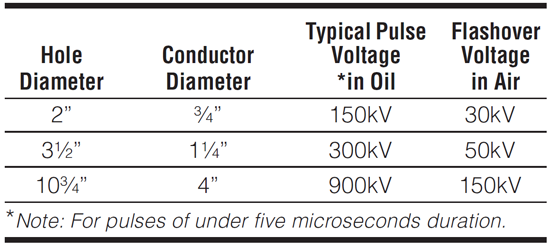Pearson Current Monitors intended for high voltage use have large hole diameters and radiused edges to keep voltage gradients low. The two standard case sizes are those with 3 1⁄2 inch and 10 3⁄4 inch inside diameters. These sizes are double shielded, as mentioned previously. The extra shield affords excellent protection from electric field penetration. Since the mounting screws ground the outer shield, a direct path to ground is provided for possible arcs from the high-voltage conductor to the case. This direct path to ground minimizes the danger of high voltage entering the instrumentation circuit. The inner shield and coaxial connector are “floating” and hence can be grounded at the oscilloscope, at the oil tank bulkhead, or wherever convenient to minimize ground loops and promote safety.
A round conductor at high potential centered in the hole of a Pearson Current Monitor results in coaxial geometry. For this arrangement, the minimum voltage gradient at the surface of the conductor occurs when the ratio of conductor radius to hole radius is 1/e. Departure in either direction from the optimum conductor radius will increase the gradient and lower the permissible operating voltage. Voltages and recommended conductor sizes are tabulated for three Pearson case sizes. Cleanliness of the local environment is necessary to achieve reliable high-voltage operation.

All Pearson Current Monitors are constructed of materials compatible with transformer oil. For detailed information regarding the care and handling of transformer oil, use of pulse transformers in transformer oil, etc., refer to Pearson “Notes on High-Voltage Pulse-Transformer Insulating Oil Care and Accidental Transformer Overvoltages” (available on request from the Pearson factory).
When the conductor in the hole of a Pearson Current Monitor operates at a high direct-current potential in transformer oil, it is recommended that a barrier composed of solid insulating material be placed between the conductor and the current monitors to prevent arcs due to foreign particles “lining up” in the dc field.
Typical barrier materials include teflon tubing, laminated paper-phenolic tubing and oil-impregnated (by vacuum) Kraft paper. If the barrier material is used as a centering device, touching both conductor and current monitor, adequate creep distance should be allowed over the shortest surface path to prevent breakdown.
At voltage levels of a few kilovolts in air, ordinary high-voltage insulated wire will suffice for the center conductor. At levels above 10 kilovolts in air, it is advisable to use a centered conductor of large diameter. As the voltage level approaches the rated voltage for the hole size, it becomes more necessary to use the optimum conductor size.
